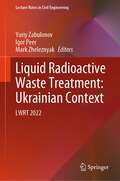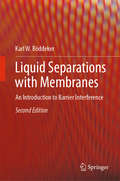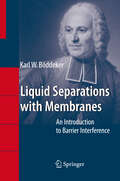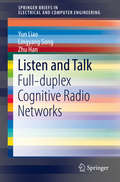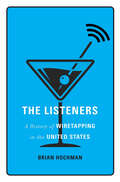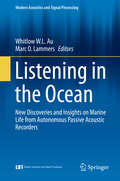- Table View
- List View
Liquid Phase Aerobic Oxidation Catalysis: Industrial Applications and Academic Perspectives
by Shannon S. Stahl Paul L. AlstersThe first book to place recent academic developments within the context of real life industrial applications, this is a timely overview of the field of aerobic oxidation reactions in the liquid phase that also illuminates the key challenges that lie ahead. As such, it covers both homogeneous as well as heterogeneous chemocatalysis and biocatalysis, along with examples taken from various industries: bulk chemicals and monomers, specialty chemicals, flavors and fragrances, vitamins, and pharmaceuticals. One chapter is devoted to reactor concepts and engineering aspects of these methods, while another deals with the relevance of aerobic oxidation catalysis for the conversion of renewable feedstock. With chapters written by a team of academic and industrial researchers, this is a valuable reference for synthetic and catalytic chemists at universities as well as those working in the pharmaceutical and fine chemical industries seeking a better understanding of these reactions and how to design large scale processes based on this technology.
Liquid Phase Epitaxy of Electronic, Optical and Optoelectronic Materials (Wiley Series in Materials for Electronic & Optoelectronic Applications #21)
by Peter Capper Michael MaukLiquid-Phase Epitaxy (LPE) is a technique used in the bulk growth of crystals, typically in semiconductor manufacturing, whereby the crystal is grown from a rich solution of the semiconductor onto a substrate in layers, each of which is formed by supersaturation or cooling. At least 50% of growth in the optoelectronics area is currently focussed on LPE. This book covers the bulk growth of semiconductors, i.e. silicon, gallium arsenide, cadmium mercury telluride, indium phosphide, indium antimonide, gallium nitride, cadmium zinc telluride, a range of wide-bandgap II-VI compounds, diamond and silicon carbide, and a wide range of oxides/fluorides (including sapphire and quartz) that are used in many industrial applications. A separate chapter is devoted to the fascinating field of growth in various forms of microgravity, an activity that is approximately 30-years old and which has revealed many interesting features, some of which have been very surprising to experimenters and theoreticians alike. Covers the most important materials within the field The contributors come from a wide variety of countries and include both academics and industrialists, to give a balanced treatment Builds-on an established series known in the community Highly pertinent to current and future developments in telecommunications and computer-processing industries.
Liquid Phase Sintering
by R.M. GermanIn the past few years there has been rapid growth in the activities involving particulate materials because of recognized advantages in manufacturing. This growth is attributed to several factors; i) an increased concern over energy utilization, ii) a desire to better control microstructure in engineermg materials, iii) the need for 1mproved material economy, iv) societal and economic pressures for higher productivity and quality, v) requirements for unique property combinations for high performance applica tions, and vi) a desire for net shape forming. Accordingly, liquid phase sintering has received increased attention as part of the growth in particulate materials processing. As a consequence, the commercial applications for liquid phase sintering are expanding rapidly. This active and expanding interest is not well served by available texts. For this reason I felt it was appropriate to write this book on liquid phase sintering. The technology of liquid phase sintering IS quite old and has been in use in the ceramics industry for many centuries. However, the general perception among materials and manufacturing engineers is that liquid phase sintering is still a novel technique. I believe the diverse technological appli cations outlined in this book will dispel I such impressions. Liquid phase. sintering has great value in fabricating several unique materials to near net shapes and will continue to expand in applications as the fundamental attrib utes are better appreciated. I am personally involved with several uses for liquid phase sintering.
Liquid Pipeline Hydraulics
by E. Shashi MenonAvoiding lengthy mathematical discussions, this reference specifically addresses issues affecting the day-to-day practices of those who design, operate, and purchase liquid pipelines in the oil, water, and process industries. Liquid Pipeline Hydraulics supplies an abundance of practical examples and applications for an in-depth understanding of liq
Liquid Pipeline Hydraulics
by E. Shashi MenonAvoiding lengthy mathematical discussions, this reference specifically addresses issues affecting the day-to-day practices of those who design, operate, and purchase liquid pipelines in the oil, water, and process industries. Liquid Pipeline Hydraulics supplies an abundance of practical examples and applications for an in-depth understanding of liq
Liquid Piston Engines: Design, Analysis And A Review Of Combustion Engines
by Aman Gupta Shubham Sharma Sunny NarayanWhether used in irrigation, cooling nuclear reactors, pumping wastewater, or any number of other uses, the liquid piston engine is a much more efficient, effective, and “greener” choice than many other choices available to industry. Especially if being used in conjunction with solar panels, the liquid piston engine can be extremely cost-effective and has very few, if any, downsides or unwanted side effects. As industries all over the world become more environmentally conscious, the liquid piston engine will continue growing in popularity as a better choice, and its low implementation and operational costs will be attractive to end-users in developing countries. This is the only comprehensive, up-to-date text available on liquid piston engines. The first part focuses on the identification, design, construction and testing of the liquid piston engine, a simple, yet elegant, device which has the ability to pump water but which can be manufactured easily without any special tooling or exotic materials and which can be powered from either combustion of organic matter or directly from solar heating. It has been tested, and the authors recommend how it might be improved upon. The underlying theory of the device is also presented and discussed. The second part deals with the performance, troubleshooting, and maintenance of the engine. This volume is the only one of its kind, a groundbreaking examination of a fascinating and environmentally friendly technology which is useful in many industrial applications. It is a must-have for any engineer, manager, or technician working with pumps or engines.
Liquid Piston Engines
by Aman Gupta Shubham Sharma Sunny NarayanWhether used in irrigation, cooling nuclear reactors, pumping wastewater, or any number of other uses, the liquid piston engine is a much more efficient, effective, and “greener” choice than many other choices available to industry. Especially if being used in conjunction with solar panels, the liquid piston engine can be extremely cost-effective and has very few, if any, downsides or unwanted side effects. As industries all over the world become more environmentally conscious, the liquid piston engine will continue growing in popularity as a better choice, and its low implementation and operational costs will be attractive to end-users in developing countries. This is the only comprehensive, up-to-date text available on liquid piston engines. The first part focuses on the identification, design, construction and testing of the liquid piston engine, a simple, yet elegant, device which has the ability to pump water but which can be manufactured easily without any special tooling or exotic materials and which can be powered from either combustion of organic matter or directly from solar heating. It has been tested, and the authors recommend how it might be improved upon. The underlying theory of the device is also presented and discussed. The second part deals with the performance, troubleshooting, and maintenance of the engine. This volume is the only one of its kind, a groundbreaking examination of a fascinating and environmentally friendly technology which is useful in many industrial applications. It is a must-have for any engineer, manager, or technician working with pumps or engines.
Liquid Radioactive Waste Treatment: LWRT 2022 (Lecture Notes in Civil Engineering #469)
by Yuriy Zabulonov Igor Peer Mark ZheleznyakThis book presents the latest scientific advancements and innovative R&D solutions for the treatment of liquid radioactive waste in the context of practical threats in Ukraine. It includes research and engineering insights from the International Conference “Liquid Radioactive Waste Treatment: Ukrainian Context” (LWRT 2022), which was held in Kyiv, Ukraine on June 30, 2022. This publication covers a wide range of topics related to the treatment and management of radioactive waste, with a particular emphasis on safety considerations. The included articles also explore various aspects of environmental engineering and innovative R&D solutions, as well as the sustainability challenges associated with radioactive waste in the context of postwar reconstruction efforts. The contributions featured in this publication were selected through a rigorous international peer-review process. The carefully curated collection of articles showcases a diverse range of exciting ideas, poised to inspire novel research directions and stimulate interdisciplinary collaborations.
Liquid Separations with Membranes: An Introduction to Barrier Interference
by Karl W. BöddekerThe plan of this book is to present the relevant thermodynamic features of fluid mixtures in contact with semipermeable barriers, then to apply this information in deriving the design requirements of individual membrane separation processes. The membranes, by this approach, are introduced by way of the mass transport and selectivity demands which they are to meet. This book gives a survey, in systematic order, of the terms and concepts by which barrier separations operate.
Liquid Separations with Membranes: An Introduction to Barrier Interference
by Karl W. BöddekerThe plan of this book is to present the relevant thermodynamic features of fluid mixtures in contact with semipermeable barriers, then to apply this information in deriving the design requirements of individual membrane separation processes. The membranes, by this approach, are introduced by way of the mass transport and selectivity demands which they are to meet. This book gives a survey, in systematic order, of the terms and concepts by which barrier separations operate.
Liquid Silicone Rubber: Chemistry, Materials, and Processing
by Johannes Karl FinkThe scientific literature with respect to liquid silicone rubbers is collected in this monograph. The text focuses on the fundamental issues such as properties, curing methods, special materials, as well as the latest development and provides a broad overview of the materials used therein. In particular, materials and compositions for liquid functional rubbers are discussed. Also, methods of curing and special properties are described, such as tracking and erosion resistance, adhesion properties, storage and thermal stability. Methods of curing are precision casting, hybrid additive manufacturing, peroxide curing, ultraviolet curing, liquid injection molding, or hot embossing. The book includes applications including automotive and underwater applications, electrical and optical uses, as well as medical uses.
Liquid Silicone Rubber: Chemistry, Materials, and Processing
by Johannes Karl FinkThe scientific literature with respect to liquid silicone rubbers is collected in this monograph. The text focuses on the fundamental issues such as properties, curing methods, special materials, as well as the latest development and provides a broad overview of the materials used therein. In particular, materials and compositions for liquid functional rubbers are discussed. Also, methods of curing and special properties are described, such as tracking and erosion resistance, adhesion properties, storage and thermal stability. Methods of curing are precision casting, hybrid additive manufacturing, peroxide curing, ultraviolet curing, liquid injection molding, or hot embossing. The book includes applications including automotive and underwater applications, electrical and optical uses, as well as medical uses.
Liquid Spray from Nozzles: Experimental and Computer Simulation of Hydrodynamics and Interphase Heat and Mass Transfer (Innovation and Discovery in Russian Science and Engineering)
by Nikolay N. SimakovThis book advances a new view of phenomena associated with the spray of liquids from a nozzle in a gas. New results of experimental studies and numerical simulation of the hydrodynamics of an emerging two-phase flow and accompanying interphase heat and mass transfer therein are presented. The book is ideal for specialists who develop and use technologies involving the spraying of liquids in a gas, such as burning and pyrolysis of liquid hydrocarbons, granulation and drying of polymers, and dust and gas scrubbing.
Liquid-Vapor Phase-Change Phenomena: An Introduction to the Thermophysics of Vaporization and Condensation Processes in Heat Transfer Equipment, Third Edition
by Van P. CareySince the second edition of Liquid-Vapor Phase-Change Phenomena was written, research has substantially enhanced the understanding of the effects of nanostructured surfaces, effects of microchannel and nanochannel geometries, and effects of extreme wetting on liquid-vapor phase-change processes. To cover advances in these areas, the new third edition includes significant new coverage of microchannels and nanostructures, and numerous other updates. More worked examples and numerous new problems have been added, and a complete solution manual and electronic figures for classroom projection will be available for qualified adopting professors.
Liquid-Vapor Phase-Change Phenomena: An Introduction to the Thermophysics of Vaporization and Condensation Processes in Heat Transfer Equipment, Third Edition
by Van P. CareySince the second edition of Liquid-Vapor Phase-Change Phenomena was written, research has substantially enhanced the understanding of the effects of nanostructured surfaces, effects of microchannel and nanochannel geometries, and effects of extreme wetting on liquid-vapor phase-change processes. To cover advances in these areas, the new third edition includes significant new coverage of microchannels and nanostructures, and numerous other updates. More worked examples and numerous new problems have been added, and a complete solution manual and electronic figures for classroom projection will be available for qualified adopting professors.
Liquidated Damages and Extensions of Time: In Construction Contracts
by Brian EgglestonLiquidated damages and extensions of time are complex subjects, frequently forming the basis of contract claims made under the standard building and civil engineering contracts. Previous editions of Liquidated Damages and Extensions of Time are highly regarded as a guide for both construction industry professionals and lawyers to this complex area. The law on time and damages continues to develop with an increasing flow of judgments from the courts. Alongside this, the standard forms of contract have also developed over time to reflect prevailing approaches to contractual relationships. Against this background a third edition will be welcomed by construction professionals and lawyers alike. Retaining the overall approach of the previous editions, the author clarifies, in a highly readable but legally rigorous way, the many misunderstandings on time and damages which abound in the construction industry. The third edition takes account of a large volume of new case law since the previous edition was published over ten years ago, includes a new chapter on delay analysis and features significantly expanded chapters on penalty clauses, the effects of conditions precedent and time-bars, and the complexities of causation.
Lise Meitner and the Dawn of the Nuclear Age
by Patricia RifeIn this captivating biography, Patricia Rife interprets both the life and times of Lise Meitner (1878-1968), the female physicist at the heart of the discovery of nuclear fission. She was a colleague and friend of many of the giants of 20th century physics: M. Planck, her Berlin mentor, A. Einstein, M. von Laue, Madame M. Curie, J. Chadwick, W. Pauli, and N. Bohr. Meitner was the first woman to earn a Ph.D. in physics at the University of Vienna, a pioneer in the research of radioactive processes and, together with her nephew Otto Robert Frisch, an interpreter of the process of nuclear fission in 1938. Yet at the end of World War II, her colleague of thirty years, radiochemist Otto Hahn alone was awarded the 1944 Nobel Prize in Chemistry for the "discovery" of nuclear fission -- a discovery based on years of research in which Meitner was directly involved before her secret escape from Nazi Germany.
LISP: Fallbeispiele mit Anwendungen in der Künstlichen Intelligenz (Künstliche Intelligenz)
by Rüdiger EsserEine Programmiersprache wird eingesetzt, um Verfahren zur Lösung von Anwen dungsproblemen auf dem Computer zu formulieren. Daher sollte das Erlernen einer Programmiersprache immer in Bezug auf ein Anwendungsgebiet erfolgen. Kennt man die Grundbegriffe einer Programmiersprache, erlangt man einen höheren Grad ihrer Beherrschung am besten durch das Studium von Programmen, die typischen Einsatzgebieten der Sprache entstammen. Dabei sollte man wiederum an realen Aufgaben orientierte praktische Programmierübungen durchführen. Auf diese Weise erhält man ein lebendiges Bild von der Sprache, lernt sie aktiv beherrschen und erwirbt gleichzeitig ein Verständnis wichtiger Begriffe, Denkweisen und Algorithmen der Einsatzgebiete. LISP ist seit jeher die dominierende Sprache in der Künstlichen Intelligenz und in der Symbolischen Mathematik. Außerdem wird es bei der systemnahen Program mierung, z. B. bei der Erstellung von Programmierumgebungen, eingesetzt. Im vorliegenden Buch wollen wir den Gebrauch von LISP in diesen Anwendungs gebieten anband einiger Fallstudien vorführen. Unter einer Fallstudie verstehen wir die Darstellung der kompletten Lösung eines Anwendungsproblems. Diese schließt insbesondere die Erörterung der algorithmischen Hilfsmittel ein. Für unsere Zwecke kann die einzelne Studie nur so umfangreich sein, daß man sie als Ganzes gut überschauen und erfassen kann.
LISS 2012: Proceedings of 2nd International Conference on Logistics, Informatics and Service Science
by Zhenji Zhang, Runtong Zhang and Juliang ZhangInformation and communication technology has helped to provide a more effective network infrastructure and development platform for logistics and service operations. In order to meet the needs of consumers, and particularly to promote low-carbon development processes, new types of services will also emerge. LISS 2012 is a prime international forum for both researchers and industry practitioners to exchange the latest fundamental advances in the state of the art and practice of logistics, informatics, service operations and service science. Experts and researchers from related fields will discuss current issues and future development opportunities, discuss and analyze developing trends and exchange the latest research and academic thought. The theme of the conference is Logistics and Service Science based on the Internet of Things.
LISS 2013: Proceedings of 3rd International Conference on Logistics, Informatics and Service Science
by Runtong Zhang Zhenji Zhang Kecheng Liu Juliang ZhangInformation and communication technology has helped to provide a more effective network infrastructure and development platform for logistics and service operations. In order to meet the needs of consumers and particularly to promote low-carbon development processes, new types of services will also emerge. LISS 2013 is a prime international forum for both researchers and industry practitioners to exchange the latest fundamental advances in the state of the art and practice of logistics, informatics, service operations and service science. Experts and researchers from related fields will discuss current issues and future development opportunities discuss and analyze developing trends and exchange the latest research and academic thought. The theme of the conference is Logistics and Service Science based on the Internet of Things.
List of Substances of the Competent Federal Government and Federal State Authorities: Category "Plants and plant parts" (BVL-Reporte #8.8)
by Bundesamt Für Verbraucherschutz Und Lebe StaffList of Substances of the Competent Federal Government and Federal State AuthoritiesPlants and plant preparations are an important part of a balanced diet. Apart from using them as fruit, vegetables or cereals we can also enjoy them as ingredients in the form of herbs or spices or enjoy them in teas. More and more exotic plants are also available whose use as food in Germany was not known up to now.Supermarkets and drugstores also sell an increasing number of products which supposedly benefit health and contain preparations which were previously used in Germany above all in pharmaceutical products.The present category "Plants and plant parts" of the List of Substances of the Competent Federal Government and Federal State Authorities was provided to facilitate the classification and evaluation of plants and plant parts regarding their use as food or food ingredients. In addition to classification under formal legal aspects the list also provides information on the possible risks involved with certain uses. The list of substances is intended as a guideline for authorities and those placing products on the market.
Listen and Talk: Full-duplex Cognitive Radio Networks (SpringerBriefs in Electrical and Computer Engineering)
by Yun Liao Lingyang Song Zhu HanThis brief focuses on the use of full-duplex radio in cognitive radio networks, presenting a novel spectrum sharing protocol that allows the secondary users to simultaneously sense and access the vacant spectrum. This protocol, called “Listen-and-talk” (LAT), is evaluated by both mathematical analysis and computer simulations in comparison with other existing protocols, including the listen-before-talk protocol. In addition to LAT-based signal processing and resource allocation, the brief discusses techniques such as spectrum sensing and dynamic spectrum access. The brief proposes LAT as a suitable access scheme for cognitive radio networks, which can support the quality-of-service requirements of these high priority applications. Fundamental theories and key techniques of cognitive radio networks are also covered.Listen and Talk: Full-duplex Cognitive Radio Networks is designed for researchers, developers, and professionals involved in cognitive radio networks. Advanced-level students studying signal processing or simulations will also find the content helpful since it moves beyond traditional cognitive radio networks into future applications for the technology.
The Listeners: A History of Wiretapping in the United States
by Brian HochmanThey’ve been listening for longer than you think. A new history reveals how—and why. Wiretapping is nearly as old as electronic communications. Telegraph operators intercepted enemy messages during the Civil War. Law enforcement agencies were listening to private telephone calls as early as 1895. Communications firms have assisted government eavesdropping programs since the early twentieth century—and they have spied on their own customers too. Such breaches of privacy once provoked outrage, but today most Americans have resigned themselves to constant electronic monitoring. How did we get from there to here? In The Listeners, Brian Hochman shows how the wiretap evolved from a specialized intelligence-gathering tool to a mundane fact of life. He explores the origins of wiretapping in military campaigns and criminal confidence games and tracks the use of telephone taps in the US government’s wars on alcohol, communism, terrorism, and crime. While high-profile eavesdropping scandals fueled public debates about national security, crime control, and the rights and liberties of individuals, wiretapping became a routine surveillance tactic for private businesses and police agencies alike. From wayward lovers to foreign spies, from private detectives to public officials, and from the silver screen to the Supreme Court, The Listeners traces the long and surprising history of wiretapping and electronic eavesdropping in the United States. Along the way, Brian Hochman considers how earlier generations of Americans confronted threats to privacy that now seem more urgent than ever.
Listening in the Ocean: New Discoveries And Insights On Marine Life From Autonomous Passive Acoustic Recorders (Modern Acoustics and Signal Processing)
by Whitlow W. L. Au Marc O. LammersThis title brings to light the discoveries and insights into the lives of many marine species made possible over the last decade by passive acoustic recorders (PAR). Pop-ups, ARF, HARP, EAR, Bprobe, C-POD Atag, and Dtag are the acronyms of some of the many PARs that have changed our understanding of how marine animals live and strive in the ocean. Various types of PARs are used by different investigators in different areas of the world. These recorders have accumulated copious amounts of very important data, unveiling previously unknown information about large marine animals. Temporal, seasonal and spatial distribution patterns have been uncovered for many marine species. There have been many discoveries, new understandings and insights into how these animals live in and utilize the ocean and the importance of acoustics in their lives. Listening Within the Ocean summarizes these important discoveries, providing both a valuable resource for researchers and enjoyable reading for non-professionals interested in marine life.
Listeria: A practical approach to the organism and its control in foods (The Practical Food Microbiology Series)
by Chris Bell Alex KyriakidesThe independent investigations some 70 years ago by E. G. D. Murray and colleagues in Cambridge (UK) and J,H. H. Pirie in Johannesburg (South Mrica) resulted in the first detailed descriptions of listeriosis (in both instances in small animals), together with the isolation and naming of Lis teria monocytogenes. These descriptions in 1926 and 1927 show the pre cision and care of these experimentalists, for not only did they show much skill and attention to detail but also great insight in surmising that the consumption of contaminated food was associated with the trans mission of listeriosis. In the words of Pirie in 1927, 'Infection can be pro duced by subcutaneous inoculation or by feeding and it is thought that it is by feeding that the disease is spread in nature. ' These observations were largely forgotten and listeriosis was regarded as a rather obscure disease of animals and occasionally humans. However, the 1980s saw dramatic changes and the 'elevation' of Listeria to a topic of concern not only amongst microbiologists (particularly food micro biologists) but also the general public.






